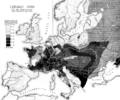Raciology facts for kids
Raciology, sometimes called racial science or racial biology, was a way of studying human groups based on the idea of "race." People who who studied raciology believed that humans could be divided into distinct races. They thought these races had different physical features, behaviors, and even intelligence levels.
Today, the term "raciology" is not used much in anthropology (the study of humans) or other sciences. This is because most scientists now agree that the idea of distinct human races, as defined by raciology, is outdated and not based on good science. Many also see it as a harmful idea that led to racism and discrimination.
Contents
What Was Raciology?
Raciology was a field of study that tried to classify people into different "races." It often focused on physical traits like skin color, hair type, and facial features. People who supported raciology believed these physical differences meant there were also differences in intelligence, character, and abilities.
This way of thinking suggested that some "races" were naturally better or more advanced than others. This idea is now widely rejected by scientists. Modern science shows that human genetic differences are very small and do not fit into neat racial categories.
A Look Back in Time
The ideas behind raciology began to appear hundreds of years ago. In the 1700s and 1800s, some European thinkers tried to create systems for classifying all living things, including humans. They used physical traits to group people.
For example, Carolus Linnaeus, a famous Swedish scientist, created one of the first systems. He divided humans into different varieties based on geography and skin color. Later, other scientists like Johann Friedrich Blumenbach also tried to classify human "races."
Early Ideas and Classifications
Many early thinkers believed that human groups had fixed traits. They often used skull shapes and sizes to try and prove their ideas. This was called craniometry. They thought that bigger skulls meant more intelligence, which was later proven wrong.
These early classifications were often based on limited knowledge and personal biases. They did not use the careful scientific methods we have today. Because of this, their ideas about race were often flawed and led to wrong conclusions.
Raciology and Social Beliefs
During the 1800s and early 1900s, raciology became linked with social and political ideas. Some people used these ideas to justify unfair treatment of certain groups. They claimed that some "races" were naturally superior and should have more power.
This way of thinking was used to support things like slavery, colonialism, and discrimination. It suggested that differences in wealth or power between groups were natural, rather than caused by social or historical reasons.
Why Raciology Is Not Used Today
Today, most scientists agree that the concept of human "races" as distinct biological groups is not accurate. Modern genetics (the study of genes) shows that human variation is much more complex. There are no clear genetic boundaries between groups that match the old racial categories.
Instead, human genetic differences tend to change gradually across geographic areas. This is called a clinal variation. For example, skin color changes gradually from lighter to darker as you move closer to the equator.
The Problem with "Race"
The idea of "race" as a biological concept has been largely replaced by the understanding that it is a social construct. This means that "race" is a concept created by societies, not a natural biological fact. People use it to categorize others, often based on visible traits.
While people do have different appearances, these differences are a tiny part of our overall genetic makeup. We are all part of one human species, Homo sapiens. The genetic differences within any "racial" group are often greater than the average differences between groups.
Harmful Effects
The ideas of raciology have caused a lot of harm throughout history. They were used to justify racism, discrimination, and even violence against people based on their supposed "race." This led to unfair laws, social injustice, and terrible events like the Holocaust.
Because of its history and lack of scientific basis, raciology is now seen as a pseudoscience. This means it pretends to be scientific but does not follow true scientific methods. It is important to understand this history to avoid repeating past mistakes.
Images for kids
-
Homo monstrosus, or Patagonian giants, from Voyage au pole sud et dans l'Océanie (Voyage to the South Pole, and in Oceania), by Jules Dumont d'Urville
-
Portrait of Arthur de Gobineau by the Comtesse de la Tour, 1876
-
Francis Galton in his later years
-
The Swedish State Institute for Racial Biology, founded in 1922, was the world's first government-funded institute performing research into racial biology. It was housed in what is now the Dean's house at Uppsala and was closed down in 1958.
See also
 In Spanish: Racismo científico para niños
In Spanish: Racismo científico para niños

























